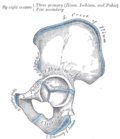| Iliac crest | |
|---|---|
 Pelvic girdle. | |
 Overview of Ilium as largest bone of the pelvis | |
| Details | |
| Identifiers | |
| Latin | crista iliaca |
| TA98 | A02.5.01.106 |
| TA2 | 1322 |
| FMA | 16914 |
| Anatomical terms of bone | |
The crest of the ilium (or iliac crest) is the superior border of the wing of ilium and the superolateral margin of the greater pelvis.






